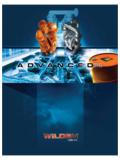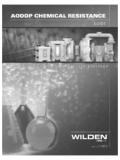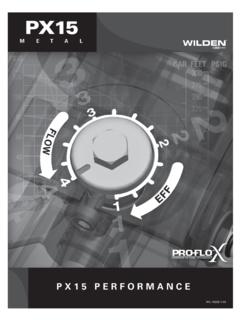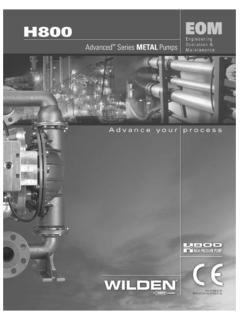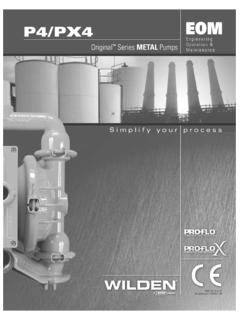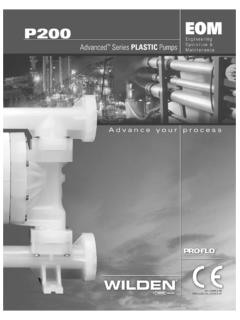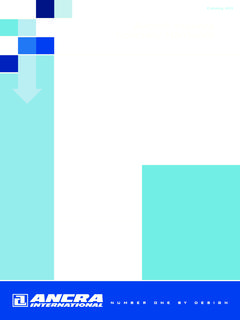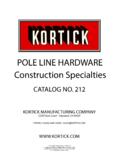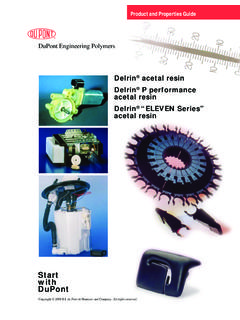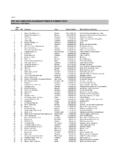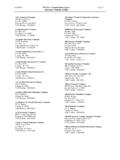Transcription of P2R - Wilden Pumps
1 P2R WIL-10150-E-05 REPLACES WIL-10150-E-04 Simplify your processEngineering Operation &MaintenanceOriginal Series PLASTIC PumpsTABLE OF CONTENTS PAGE #SECTION 1 CAUTIONS - READ FIRST!.. 1 SECTION 2 PUMP DESIGNATION SYSTEM .. 2 SECTION 3 HOW IT WORKS (PUMP & AIR SYSTEMS) .. 3 SECTION 4 DIMENSIONAL DRAWING A. P2R PLASTIC .. 4 SECTION 5 PERFORMANCE CURVES A. P2R PLASTIC Rubber-Fitted .. 5 B. P2R PLASTIC 5 C. P2R PLASTIC PTFE-Fitted .. 6 SECTION 6 SUCTION LIFT CURVES & DATA .. 6 SECTION 7 INSTALLATION AND OPERATION A. Installation .. 7 B. Operation & Maintenance .. 8 C. Troubleshooting .. 9 SECTION 8 DIRECTIONS FOR DISASSEMBLY/REASSEMBLY A. P2R PLASTIC Wetted Path Tools Required, Cautions .. 10 B. Pro-Flo Air Valve/Center Section Disassembly, Cleaning, Inspection.
2 13 C. Reassembly Hints & Tips, Torque Specs .. 15 D. PTFE Gasket Kit Installation .. 16 SECTION 9 EXPLODED VIEW/PARTS LISTING A. P2R PLASTIC Rubber/TPE-Fitted .. 18 B. P2R PLASTIC PTFE-Fitted .. 20 SECTION 10 ELASTOMER OPTIONS .. 22 Class I & II OzoneDepleting Clean Air ActAmendments of 19901 Wilden PUMP & ENGINEERING, LLCWIL-10150-E-05 SECTION 1P2R PLASTICCAUTIONS READ FIRST!TEMPERATURE LIMITS:Polypropylene 0 C to 79 C 32 F to 175 FPVDF 12 C to 107 C 10 F to 225 FBuna-N C to C 10 F to 180 FNeoprene C to C 0 F to 200 FEDPM C to C 60 F to 280 F Polyurethane C to C 10 F to 150 F Saniflex C to C 20 F to 220 F PTFE C to C 40 F to 220 FTetra-FlexTM PTFE to C 40 F to 225 F Neoprene BackedTetra-FlexTM PTFE -10 to 137 C 14 F to 280 F EPDM BackedTetra-FlexTM to C 40 F to 225 FViton 40 C to C 40 F to 350 FWil-Flex 40 C to C 40 F to 225 F CAUTION: When choosing pump materials, be sure to check the temperature limits for all wetted compo-nents.
3 Example: Viton has a maximum limit of C (350 F) but polypropylene has a maximum limit of only 79 C (175 F) .CAUTION: Maximum temperature limits are based upon mechanical stress only. Certain chemicals will significantly reduce maximum safe operating tempera-tures. Consult engineering guide for chemical compat-ibility and temperature : Always wear safety glasses when operat-ing pump. If diaphragm rupture occurs, material being pumped may be forced out air : Prevention of static sparking If static sparking occurs, fire or explosion could result. Pump, valves, and containers must be properly grounded when handling flammable fluids and whenever dis-charge of static electricity is a hazard. CAUTION: Do not exceed bar (125 psig) air supply : P2R Pumps are made of virgin plastic and are not UV stabilized. Direct sunlight for prolonged periods can cause deterioration of : Before any maintenance or repair is attempted, the compressed air line to the pump should be disconnected and all air pressure allowed to bleed from pump.
4 Disconnect all intake, discharge and air lines. Drain the pump by turning it upside down and allowing any fluid to flow into a suitable container. CAUTION: Blow out air line for 10 to 20 seconds before attaching to pump to make sure all pipe line debris is clear. Use an in-line air filter. A 5 (micron) air filter is : Tighten clamp bands and retainers prior to installation. Fittings may loosen during : When installing PTFE diaphragms, it is impor-tant to tighten outer pistons simultaneously (turning in opposite directions) to ensure tight : Before starting disassembly, mark a line from each liquid chamber to its corresponding air chamber. This line will assist in proper alignment during : Verify the chemical compatibility of the pro-cess and cleaning fluid to the pump s component mate-rials in the Chemical Resistance Guide (see RBG E4).CAUTION: When removing the end cap using com-pressed air, the air valve end cap may come out with considerable force.
5 Hand protection such as a padded glove or rag should be used to capture the end cap. CAUTION: P2R PTFE-fitted Pumps come standard from the factory with expanded PTFE gaskets. (See Gasket Kit Installation in Section CAUTION: Do not over-tighten the air inlet reducer bushing. Too much torque on the reducer bushing may damage the air valve muffler plate. Do not exceed N m (8in-lbs).NOTE: When reinstalling the outer pistons, apply two (2) drops of Loctite 246 to the shaft internal threads before the diaphragm : MOST ELASTOMERIC MATERIALS USE COLORED DOTS FOR is registered trademarks of DuPont Dow PUMP & ENGINEERING, LLCWIL-10150-E-05 SECTION 2 Wilden PUMP DESIGNATION SYSTEM*O-RINGS NOT ORIGINAL PLASTIC25 mm (1") PumpMaximum Flow Rate:140 LPM (37 GPM)MATERIAL CODESWETTED PARTS & OUTER PISTONKK = PVDF / PVDFPP = POLYPROPYLENE / POLYPROPYLENEPK = POLYPROPYLENE / PVDFCENTER SECTIONLL = ACETALPP = POLYPROPYLENEAIR VALVEL = ACETALP = POLYPROPYLENEDIAPHRAGMSBNS = BUNA-N (Red Dot)EPS = EPDM (Blue Dot)FSS = SANIFLEX [Hytrel (Cream)]NES = NEOPRENE (Green Dot)PUS = POLYURETHANE (Clear)TEU = PTFE W/EPDM BACK-UP (White)TNU = PTFE W/NEOPRENE BACK-UP (White)TSU = PTFE W/SANIFLEX BACK-UP (White)VTS = VITON (White Dot)WFS = WIL-FLEX [Santoprene (Orange Dot)]VALVE BALLBN = BUNA-N (Red Dot)EP = EPDM (Blue Dot)FS = SANIFLEX [Hytrel (Cream)]NE = NEOPRENE (Green Dot)PU = POLYURETHANE (Brown)TF = PTFE (White)VT = VITON (White Dot)WF = WIL-FLEX [Santoprene (Orange Dot))]
6 ]VALVE SEATK = PVDFP = POLYPROPYLENEVALVE SEAT O-RINGBN = BUNA-NPU = POLYURETHANE (Brown)TV = PTFE ENCAP. VITON WF = WIL-FLEX [Santoprene ]SPECIALTY CODES0100 Wil-Gard II 110V0102 Wil-Gard II sensor wires ONLY0103 Wil-Gard II 220V0206 PFA coated hardware, Wil-Gard II sensor wires ONLY0400 P2 plastic0402 P2 plastic, PFA coated hardware0404 P2 plastic, DIN flange0406 P2 plastic, PFA coated hardware, DIN flange0415 P2 plastic, Wil-Gard II sensor wires ONLY0416 P2, PFA coated hardware, Wil-Gard II sensor wires ONLY0420 P2 plastic, Wil-Gard II 110V0423 P2 plastic, PFA coated hardware, Wil-Gard II 110V0424 P2 plastic, Wil-Gard II 220V, DIN flange0426 P2 plastic, PFA coated hardware, Wil-Gard II 220V, DIN flange0428 P2 plastic, Wil-Gard II 220V0430 P2 plastic, SS outer pistons0502 PFA coated hardware0560 Split manifold0561 Split manifold, PFA coated hardware0563 Split manifold, discharge ONLY0564 Split manifold, inlet ONLY0603 PFA coated hardware.
7 Wil-Gard II 110V0608 PFA coated hardware, Wil-Gard II 220V0660 Split manifold, Wil-Gard II 110V0661 Split manifold, PFA coated hardware,Wil-Gard II 110 VLEGENDP2 / XXXXX / XXX / XX / XXX /XXXXO-RINGSMODELVALVE SEATVALVE BALLSDIAPHRAGMSAIR VALVECENTER SECTIONWETTED PARTS & OUTER PISTONSPECIALTYCODE(if applicable)FIGURE 1 The air valve directs pressurized air to the back side of diaphragm A. The compressed air is applied directly to the liquid column sepa-rated by elastomeric diaphragms. The diaphragm acts as a separation membrane between the compressed air and liquid, balancing the load and removing mechanical stress from the diaphragm. The compressed air moves the diaphragm away from the center block of the pump. The opposite diaphragm is pulled in by the shaft connected to the pressurized diaphragm. Diaphragm B is on its suction stroke; air behind the diaphragm has been forced out to the atmosphere through the exhaust port of the pump.
8 The movement of diaphragm B toward the center block of the pump creates a vacuum within chamber B. Atmospheric pressure forces fluid into the inlet manifold forc-ing the inlet valve ball off its seat. Liquid is free to move past the inlet valve ball and fill the liquid chamber (see shaded area).FIGURE 2 When the pressurized diaphragm, diaphragm A, reaches the limit of its discharge stroke, the air valve redirects pressurized air to the back side of diaphragm B. The pressurized air forces diaphragm B away from the center block while pulling diaphragm A to the center block. Diaphragm B is now on its discharge stroke. Diaphragm B forces the inlet valve ball onto its seat due to the hydraulic forces developed in the liquid chamber and manifold of the pump. These same hydraulic forces lift the discharge valve ball off its seat, while the opposite discharge valve ball is forced onto its seat, forcing fluid to flow through the pump discharge.
9 The movement of diaphragm A toward the center block of the pump creates a vacuum within liquid chamber A. Atmospheric pressure forces fluid into the inlet manifold of the pump. The inlet valve ball is forced off its seat allowing the fluid being pumped to fill the liquid 3 At completion of the stroke, the air valve again redirects air to the back side of diaphragm A, which starts diaphragm B on its exhaust stroke. As the pump reaches its original starting point, each diaphragm has gone through one exhaust and one discharge stroke. This consti-tutes one complete pumping cycle. The pump may take several cycles to completely prime depending on the conditions of the PUMP & ENGINEERING, LLCSECTION 3 THE Wilden PUMP HOW IT WORKSPRO-FLO AIR DISTRIBUTION SYSTEMOPERATION HOW IT WORKSThe Pro-Flo patented air distribution sys-tem incorporates three moving parts: the air valve spool, the pilot spool, and the main shaft/diaphragm assembly.
10 The heart of the system is the air valve spool and air valve. As shown in Figure A, this valve design incorporates an unbalanced spool. The smaller end of the spool is pressur-ized continuously, while the large end is alternately pressurized then exhausted to move the spool. The spool directs pressurized air to one air chamber while exhausting the other. The air causes the main shaft/diaphragm assembly to shift to one side discharging liquid on that side and pulling liquid in on the other side. When the shaft reaches the end of its stroke, the inner piston actuates the pilot spool, which pressurizes and exhausts the large end of the air valve spool. The repositioning of the air valve spool routes the air to the other air AWIL-10150-E-05 The Wilden diaphragm pump is an air-operated, positive displacement, self-priming pump. These drawings show the flow pattern through the pump upon its initial stroke.
